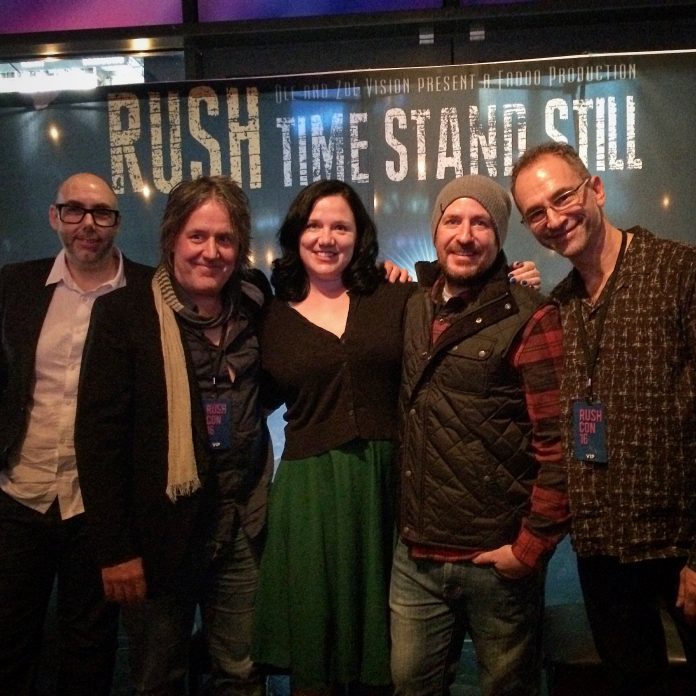
In 2015, Bala resident Bryan Gardner was asked to contribute to Canadian music history by editing the documentary Rush: Time Stand Still, which covers the iconic band’s final tour after 40 years on the road.
The documentary was released in theatres Nov. 2016 and later won a Canadian Screen Award for Best Biography or Arts Documentary. Since the death of musical legend and Rush drummer Neil Peart on Jan. 7, Gardner has been reflecting on his time editing the film, which started as a way to document rock’s most loyal fan base and their relationship with the band, according to Gardner. It ended up as an homage and farewell to Rush’s touring life, which was characterized by high energy athletic three-hour sets that showcased their exceptional musical talents. As editor for the film, Gardner was given hours upon hours of footage along with the task to craft it into a narrative.
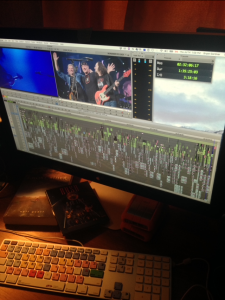
“It was probably the toughest project that I ever went through for a lot of reasons, but the amount of footage was definitely one of them,” Gardner said. “When we first set out to do this project, it was not in any way about saying it was the end.”
In total, Gardner was given 12 terabytes of footage to work with. After going through it and seeing Peart’s interview for the film, it became clear to Gardner that the emerging story was one about the end of an era.
“Real storytelling isn’t to try and control the story and make it what you want,” he said. “It’s like how artists say, ‘The sculpture was always there, I cleared away the pieces.’ That’s really what I tried to do was boil it right down to what the real hardcore story was.”
Gardner was asked to work on the project by Allan Weinrib, producer of the documentary and brother of Rush bassist and singer Geddy Lee. Gardner and Weinrib worked together on a 10-episode docuseries called Draft Year, which introduced Weinrib to Gardner’s storytelling abilities.
“Bryan was instrumental in helping structure the film,” Weinrib said. “He brought a lot of storytelling skills to the table, and he helped balance it out between what the director wanted and what production felt like should be happening in the film. It takes a little bit to try and find the story in the documentary, and Bryan certainly helped immensely in that.”
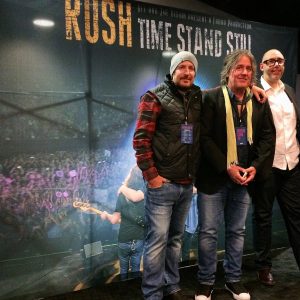
For Weinrib, it was difficult to see the band’s touring life come to an end, but it was clear while making the film that the band was not going to be a touring entity anymore.
“It’s a bit of an emotional roller coaster for the fans as well as myself because I had worked on so many tours leading up to it and all that work is going to come to an end as well,” Weinrib said. “Watching the film, you become that fan yourself and you realize what a momentous occasion it is that you’re witnessing. That emotion always just overwhelms you, so it was difficult at times to watch the rough cuts because you just get reminded of that moment in time.”
The process was an emotional one for Gardner as well, but for him, his emotions were a sign of success. He said he knows he’s on point with a project when he’s laughing and crying with the footage and with the direction of the story that he’s putting together.
“Every word that’s said in that film, every dialogue, every order, every shot change, I put there out of those 12 terabytes that boils down to 90 gigs of data,” Gardner said. “That took a lot, and I left a lot of tears on that keyboard.”

As Gardner sifted through the massive amounts of footage, his wife, Christina Shane, witnessed his dedication to the project as he worked away in his home editing suite, which looked over the Kee to Bala, where Rush played their only show in Muskoka in 1975 — the same year Gardner was born.
“It is always interesting to watch a creative process and I find this particularly true of Bryan and his craft,” Shane said. “He is a storyteller by nature and he invests himself into getting to know the character and their respective story.”

Sometimes she would find Gardner at his computer working through countless hours of footage while other times she’d come across him reading Peart’s book Ghost Rider on the dock or listening to Rush while he sipped his morning coffee. He would work in his home editing suite for hours on end, sometimes 16 to 18 hours at a time, toiling into the early hours of the morning.
“He worked on the film in his suite just below our bedroom and, as much as he tried to be respectful of my sleep, he often worked into the late hours of the evening and more times than I can count I woke up to the same music and words,” she said, recounting the first few lines of Rush’s hit song “Tom Sawyer.” “It became like a funny lullaby as I drifted back off to sleep.”
While Gardner wouldn’t have called himself a fan at the beginning of the project, he’s since become a fan, not just of the music, but of the members themselves. To him, the fact that the band members worked together happily for more than four decades with much of the same crew over the years says a lot about them.
“Long relationships are an indication of quality character people and that’s really what I became a fan of more than anything else is who these people are,” he said.
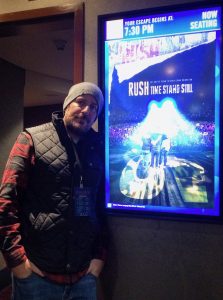
After feeling like he got to know the band members throughout his work on the film, it was difficult for Gardner to learn of Peart’s passing, but he also immediately thought about how devastating the news would be for their many diehard fans.
He noted that at various places in the film, it appears that the same footage is being used because of the presence of the same people, but really, they were fans that would come to show after show, spending as much as $2,000 to $3,000 on floor tickets. Rush fans are often described as the most loyal fans in rock and roll, and their love for the band has been evident in the days and weeks following Peart’s death.
“It’s one thing for the band to stop touring, it’s another thing to know that they’re gone outright,” Gardner said. “It feels like how you would feel for a really good friend or a family member when they lose somebody that’s in their family. These bonds are that tight and that close.”
One scene in the film shows crowds of Rush fans protesting the fact that the band had not yet been inducted into the Rock and Roll Hall of Fame. Hundreds of people stood clad in Rush gear, holding signs in support of the Canadian rock legends.
“For the excitement and energy they had when they finally got the recognition, there’s that same energy in the sadness and the devastation of the loss because 67 is far too young for anybody, let alone an artist like Neil,” Gardner said.
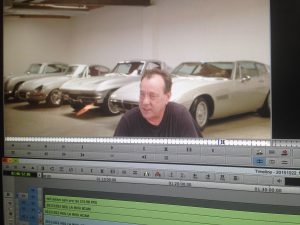
Gardner sat down to watch the documentary the day that he heard of Peart’s death. The band members and others around them made many comments in the film about the significance of the end and, though they were talking about the end of touring, hearing their comments after Peart’s death made them much more powerful, Gardner said.
“I just feel very, very proud and very fortunate that I was drawn in to be able to craft a story of this magnitude for a hardcore, traditional Canadian institution,” Gardner said. “There’s really nothing else like it that I’ve ever done in my career, and I don’t know that there ever will be.”
Find Rush: Time Stand Still on services including Crave, Bell Fibe, iTunes, Qello, Youtube and Google Play.







